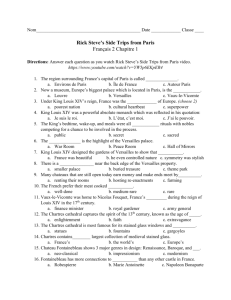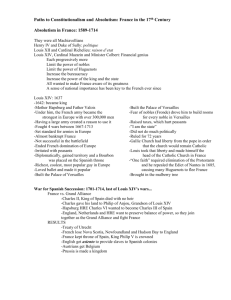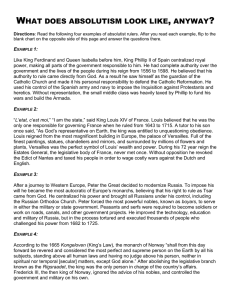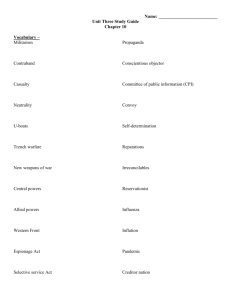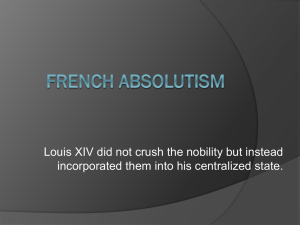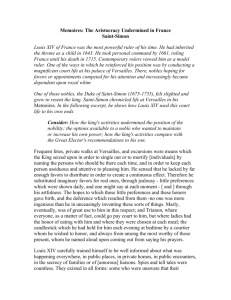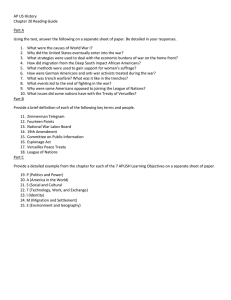history of versailles
advertisement
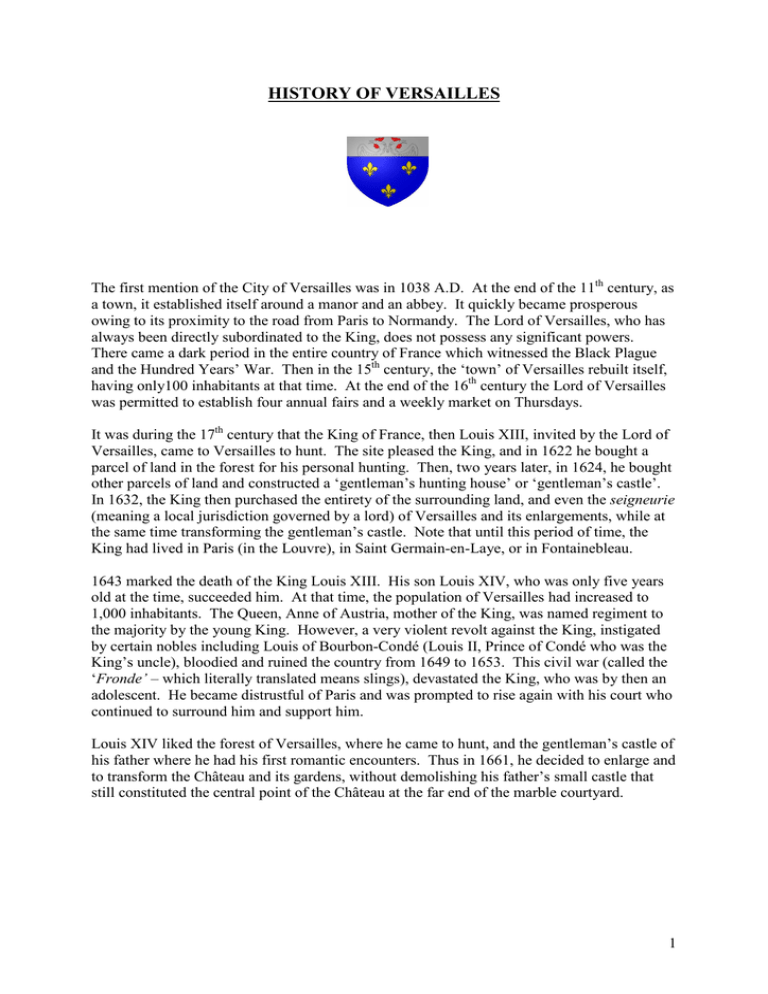
HISTORY OF VERSAILLES The first mention of the City of Versailles was in 1038 A.D. At the end of the 11th century, as a town, it established itself around a manor and an abbey. It quickly became prosperous owing to its proximity to the road from Paris to Normandy. The Lord of Versailles, who has always been directly subordinated to the King, does not possess any significant powers. There came a dark period in the entire country of France which witnessed the Black Plague and the Hundred Years’ War. Then in the 15th century, the ‘town’ of Versailles rebuilt itself, having only100 inhabitants at that time. At the end of the 16th century the Lord of Versailles was permitted to establish four annual fairs and a weekly market on Thursdays. It was during the 17th century that the King of France, then Louis XIII, invited by the Lord of Versailles, came to Versailles to hunt. The site pleased the King, and in 1622 he bought a parcel of land in the forest for his personal hunting. Then, two years later, in 1624, he bought other parcels of land and constructed a ‘gentleman’s hunting house’ or ‘gentleman’s castle’. In 1632, the King then purchased the entirety of the surrounding land, and even the seigneurie (meaning a local jurisdiction governed by a lord) of Versailles and its enlargements, while at the same time transforming the gentleman’s castle. Note that until this period of time, the King had lived in Paris (in the Louvre), in Saint Germain-en-Laye, or in Fontainebleau. 1643 marked the death of the King Louis XIII. His son Louis XIV, who was only five years old at the time, succeeded him. At that time, the population of Versailles had increased to 1,000 inhabitants. The Queen, Anne of Austria, mother of the King, was named regiment to the majority by the young King. However, a very violent revolt against the King, instigated by certain nobles including Louis of Bourbon-Condé (Louis II, Prince of Condé who was the King’s uncle), bloodied and ruined the country from 1649 to 1653. This civil war (called the ‘Fronde’ – which literally translated means slings), devastated the King, who was by then an adolescent. He became distrustful of Paris and was prompted to rise again with his court who continued to surround him and support him. Louis XIV liked the forest of Versailles, where he came to hunt, and the gentleman’s castle of his father where he had his first romantic encounters. Thus in 1661, he decided to enlarge and to transform the Château and its gardens, without demolishing his father’s small castle that still constituted the central point of the Château at the far end of the marble courtyard. 1 Versailles in 1688 Parties were frequently given in the gardens of the Chateau of Versailles, and on May 6, 1682, the King and his court installed themselves permanently in Versailles. Louis XIV wanted this Chateau to be the reflection of his strength and of his magnitude: the most sumptuous Château in the world for the most celebrated King of the world. The enlargement and embellishment continued. Louis XIV lived in the Chateau during his entire life while construction continued. One can only imagine the scene of a crowd of workers with their tools amongst elegant courtesans with ribbons tied around them! Versailles in 1675, viewed from the gardens 2 The city grew around the refurbishment of the Chateau – a flood of merchants, servants, guards and military officers… In 1671, a decree made by the King, which is still in force today, established that the height of the construction surrounding the Château could not surpass the height of the Château; this is why the bell on the top of Notre Dame Cathedral and the spire appear to be so low. This decree established the plan of the city. Avenue de Paris was directly in line with the Château, with a symmetry of the Holy neighborhoods of Louis to the south, and Our Lady to the north of this axis. The Hall of Mirrors was finished only in 1684. The Château and the gardens look similar even to this day. The room of the King is found at the center of the Château in the former sector of Louis XIII. On August 25th, the day of the Holy Louis, the sun set directly in line with the big canal and the King’s bedroom. At the time of the death of Louis XIV, in 1715, the city had 30,000 inhabitants. His great grandson succeeded to the throne; Louis XV was only 5 years old. His govern brought back the King and his court to Paris. Versailles entered a dormant period. In 1722, Louis XV came back to Versailles which then boasted 24,000 inhabitants. The city resumed his development and returned to normalcy. In 1744, the population increased to 37,000 inhabitants. During the reign of Louis XV, the Château underwent internal transformations and the gardens were modified. In the city, the Ministry of Foreign Affairs and the Ministry of the Navy were established. Louis XV died in 1774, and his grandson Louis XVI succeeded him. He married Marie-Antoinette who oversaw the restoration of the small Trianon and constructed the hamlet. In 1783, the Treaty of Versailles was signed establishing the independence of the United States (at the Ministry of Foreign Affairs, which is today a municipal library). On September 19, 1783 the brothers Montgolfier succeeded in launching the first hot air balloon at the Château in front of the King. The balloon transported a sheep, a rooster and a duck and covered a distance of 3.5 Km. In 1789, on the eve of the revolution, Versailles contained 50,000 inhabitants. Versailles, which had been the seat of supreme power, became, on May 5, 1789 the cradle of the revolution: the date of the meeting of the Estates General. The abolition of the feudal system there was proclaimed on August 4, 1789. October 6, 1789, a crowd came from Paris, invaded the Château and brought the King and his family back to Paris. The Château no longer existed. It was left either pillaged or sold with the furnishings and art objects to be found in different parts of the world to this day. The population of Versailles declined to 24,000 inhabitants by 1824. Louis-Philippe, the last King of France, saved the Château from complete ruin by transforming it into a national museum in 1837. It was during this time that Versailles became linked to Paris by two train lines – one on the right bank in 1839 and the other leading to the left bank of Paris in1840. Versailles found itself again occupied, this time by the Prussians in 1870 after the defeat of the Emperor Napoléon III. In January 18, 1871, Guillaume the First was proclaimed the German Emperor in the Hall of Mirrors. This marked the birth of the first German Reich. Versailles was again the political center of France from 1871 to 1879 until an insurrection brought power back to Paris. The first World War ended officially at Versailles, in the Hall of Mirrors where, on June 28 1919, the Treaty of Versailles was signed (ending the American Revolutionary War) with 3 President Clémenceau representing France, Lloyd George representing the United Kingdom, Orlando representing Italy, and President Wilson representing the United States. This treaty was the basis of the creation of the Society of the Nations (precursor to the United Nations). Reoccupied in 1940, Versailles was liberated on August 24, 1944 (under the watch of Saint Louis) by the 2nd armored division of the General Leclerc. MODERN VERSAILLES The city developed according to the plan designed by Louis XIV, who, in the 18th Century inspired the layout of the city of Washington. Versailles is the Prefecture of the department of the Yvelines and has close to 90,000 inhabitants. Regional administration sits there: the Prefecture and the general counsel. Versailles also has one of 30 French universities with approximately 14,000 students. This is also a garrison city, which inherited role of the monarchy. Several military organizations are located in Versailles, including the 5th regiment of military engineers, the national French police force (that includes, among others, the GIGN), and the central location for the equipment of the land army… In terms of economics - tourism, administration, and the army constitute the principal sectors of activity in Versailles: for example, Nexter (for armament, assault tanks, rifles), Citroën Sport (rally cars and the champion of world rallies led Sébastien Loeb in the last years). There are city congresses and theater (every year in June, the ‘month of Molière’ the streets are animated with theatrical renditions). The theater Montansier, constructed in 1780, was the 1st French theater. It is a city of commerce with, in particular, its renowned markets. 4

